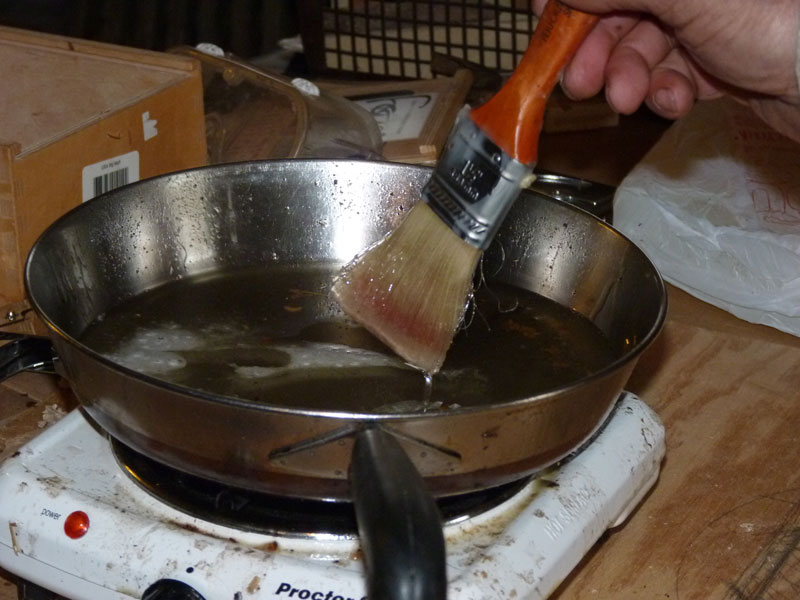I was excited to attend another workshop at Strawbale Studio, this one on Mushroom Cultivation lead by my good friend Paul. I’ve blogged about starting mushroom beds before–this post will cover mushroom log inoculation, which is one of the things we covered in the workshop.
Why inoculate mushroom logs?

Fresh medicinal and gourmet mushrooms grow in a variety of circumstances–including in the wild on old, rotting logs. We can inoculate logs directly to encourage mushroom growth and get a wonderful harvest of mushrooms (and I should add that gourmet and medicinal mushrooms are hard to find at farmer’s markets, at least in this area). Gourmet and medicinal mushrooms, such as Shiitake, Oyster, Chicken of the Woods, Reishi, and Turkey Tail, are a wonderful addition to a localvore diet, and growing them on your own property means less in terms of fossil fuel consumption. Mushroom log inoculation has a long history (most early experiments with Shitake, for example, took place in Japan and later China), and its actually pretty simple for the average person to do.
To inoculate logs, you will need either plug spawn or sawdust spawn. We used Shiitake plug spawn from Easygrow Mushrooms, which is a fantastic local South-East Michigan Company.
Mushroom logs as part of permaculture design.
With the exception of plug spawn, which you do need to order (and we are lucky enough here to obtain it locally from two farmer’s markets), the rest of your materials should be tools that you likely already have and local wood. This makes mushroom growing a rather sustainable activity, and one that reduces your impact. This is especially true because many mushrooms, such as Shiitake, are shipped the whole way from China. Other mushrooms, like the most amazing Chicken of the Woods, which really does taste like chicken, are rarely if ever available commercially. So growing your own mushrooms increases your own resiliency, allows you to use wood that is already available, and reduces your own demands on the system.
The process of innoculating logs.
I’m going to use Shiitake mushrooms as my example because that’s what we did in our workshop.
1) Obtain very fresh, hardwood logs with thick bark. You can use fresh fallen hardwood (such as if a tree comes down after a storm). You can also cut trees yourself (of a manageable size), for shitake, a non-aromatic hardwood such as oak, cottonwood, elm or maple works well (we used oak for our logs–how druidic!). Cutting is suggested for the fall, winter or spring. Obviously, we did ours in the spring! Try not to damage your logs as you cut them much–non-wanted fungus can invade logs with lots of damage easier than those with good, thick bark.

2) Stack your logs off the ground. The key here is making sure no dirt comes in contact with the log. This is critically important, as every gram of dirt contains over 12,000 types of fungus and spawn–and you want a pure log to inoculate. We stacked ours on pallets. If your logs do get dirty, you can slice the ends off of them.
3) Wait 1-2 weeks. There is some debate about the next part–some mushroom experts say you need to wait 1-2 weeks at this point, while others say you can inoculate almost immediately. We waited 2 weeks on our logs. The thinking behind the wait period is that trees typically have an anti-fungal properties, and if you innoculate sooner than two weeks, those properties may interfere with your mushroom logs.
4) Drill your logs. Holes for plug spawn (which is what we were using) can be drilled with a 5/16″ bit or a special bit (which our workshop leader, Paul, had that he purchased from Easy Grow Mushrooms). Drill holes about 1″ deep and then immediately innoculate. The holes should be drilled in a grid pattern, starting about 2″ from the edge of the log, and then going every 6″ or so with about 3″ between rows.

5) Inoculate your logs. Place the plug spawn in your log, and then use a rubber mallet to pound the plug into the log.


6) Wax your plugs and any other “injuries” on the log. Melt wax (a little crock pot is good for this) and then wax over each of the areas you plugged, making sure a good seal is obtained. This is to prevent any other fungus from getting into the plug areas. You can also wax areas you damaged (like a place where you trimmed off a smaller branch or where you damaged the bark). DO NOT wax the ends of the log.


7) Label your logs. You should get in the habit of labeling your logs with the kind and date. We labeled ours by cutting up old soda and beer cans, using the inside of the can, we used a nail to write into the can, and then stapled the metal tag to the end of the log.

8) Stack your mushroom logs off the ground in a shaded area. If you stack your logs on the ground, again, the dirt can contaminate them. If you are doing a lot of logs, you can stack them in a grid pattern. If you are doing only a few, you can just stack them on bricks. Do stack it somewhere you can remember to check on it every once in a while!

9) Every 6 weeks or so, soak your log (s). You don’t want your log to dry out, so while the spores are spreading, you can make sure they have enough moisture.
10) In 9-12 months, enjoy mushrooms! Obviously, harvest is the best part. Our logs haven’t gotten this far, but what we learned was that we should cut, rather than pull, mushrooms. Cutting mushrooms ensures that you aren’t disrupting the mycelium (which is the body of the fungus, the mushroom itself is just the reproductive organ). When your logs really get going, you can harvest quite a bit!




Oooh, I can probably find the space to do this in my garden. 🙂 I’ll find out whether those plugs are available in the UK. Love mushrooms! Hugs, Lex xxx
I hope you can find some! I’m sure you can–mushroom growing is becoming a very popular thing!
Even though you’re “planting” a specific type of mushroom, be sure you know exactly what that mushroom looks like when it sprouts. It seems to me it would still be possible for wild mushrooms to grow out of your log, which could be poisonous. They usually grow on rotten logs, but you literally can’t be too careful with mushrooms. My husband is something of an amateur mycologist, and we eat wild mushrooms frequently, but you must know exactly what you’re picking. Not to be alarmist though–bon appetit!
We put dowels through stumps all through our woods. Did not bother with the wax, did not seem to be needed. There were some wild Oysters, Angel Wings, Panellus, and other mushrooms flourishing in the woods already, so we just inoculated the new stumps with things we wanted more of.
Did you have issues with the stumps being old? I was told that you had to get fresh wood for them to really work. I haven’t had much success with the mushroom logs–except shiatake :).
[…] skills, such as cob building and artwork, strawbale construction and natural building, growing mushrooms, barn raising, rocket stoves, composting, food preservation, candle making, and so much more. […]